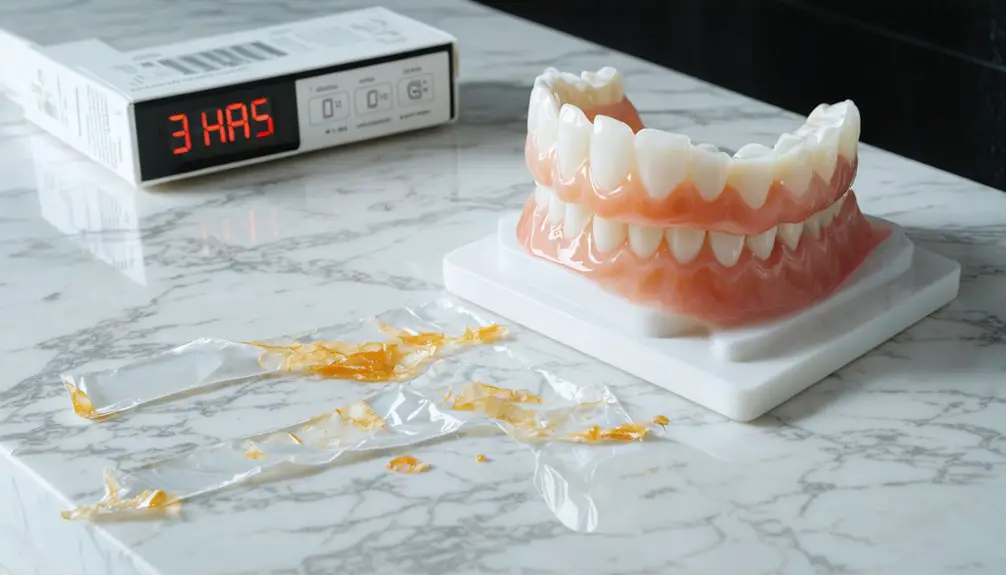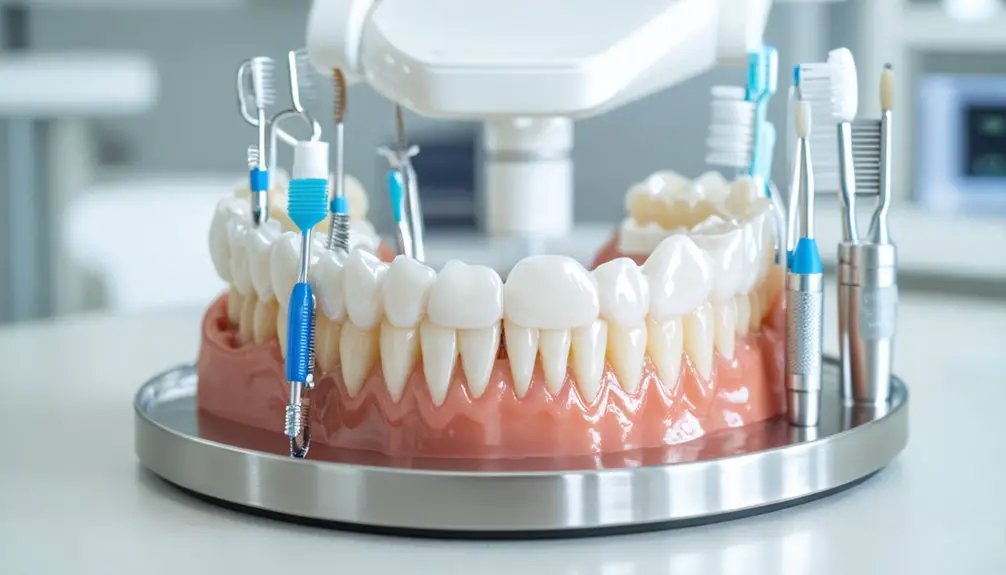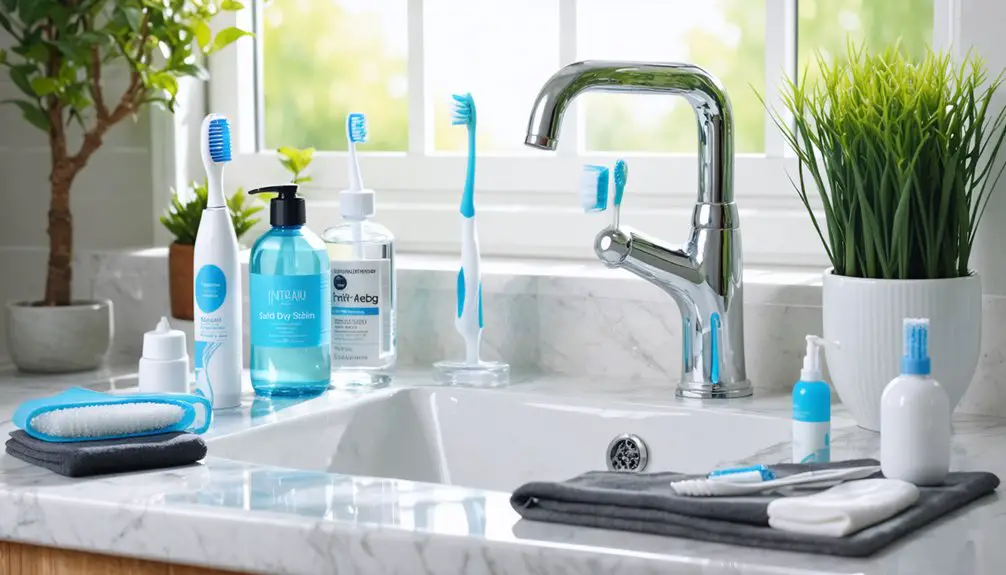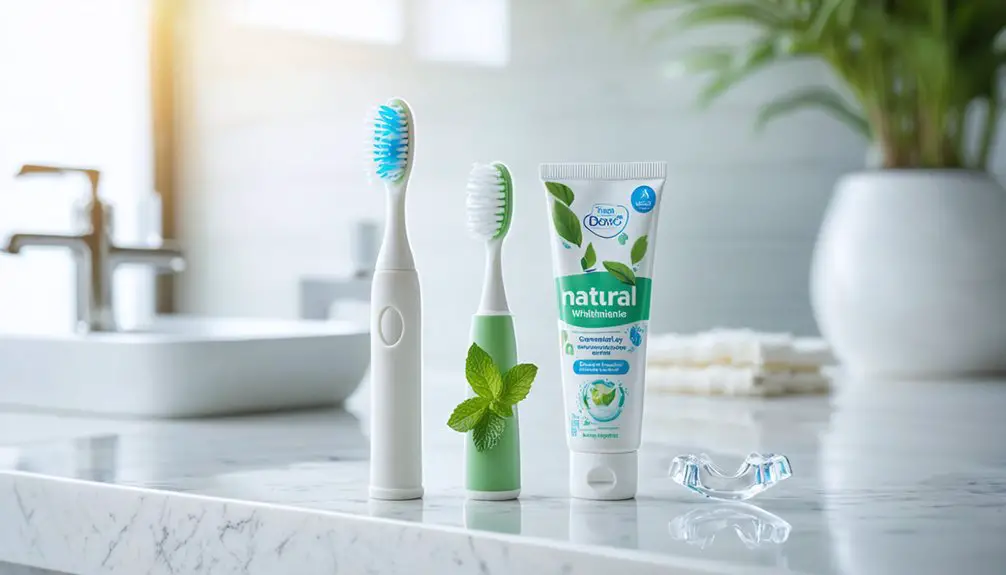To avoid the dangers of whitening strips, don’t exceed the recommended wear time of 20-30 minutes per session, and limit treatments to once daily for 10-14 days. Watch for signs of overuse like sharp pain, gum inflammation, or increased tooth sensitivity. Choose strips with the ADA Seal of Acceptance, and maintain proper intervals between treatments. If irritation occurs, stop use immediately and allow recovery time. Understanding the science behind tooth whitening will help you achieve safer, more effective results.
Key Takeaways
- Follow recommended treatment intervals of once or twice daily for 10-14 days, allowing proper healing time between whitening sessions.
- Choose strips with ADA Seal of Acceptance and lower peroxide concentrations (5-6%) to minimize sensitivity and gum irritation.
- Stop treatment immediately if experiencing sharp pain, persistent tooth sensitivity, gum swelling, or uneven tooth coloration.
- Apply strips carefully within tooth boundaries to avoid gum contact and remove promptly after recommended wear time.
- Use desensitizing toothpaste before whitening and maintain good oral hygiene with fluoride products to protect enamel.
Understanding Whitening Strip Safety Basics
When choosing teeth whitening strips, understanding proper safety protocols is crucial for achieving ideal results while protecting your oral health.
The ADA Seal of Acceptance serves as your key indicator of whitening ingredient efficacy, confirming that peroxide-based strips meet rigorous clinical safety standards. Products with ADA approval importance have undergone thorough testing to verify they won’t damage your enamel when used as directed.
To guarantee safe application, always start with clean, dry teeth and avoid flossing or brushing for an hour before use. Whitening strips containing hydrogen peroxide concentrations between 10% and 22% are most commonly available for at-home use. These strips provide a cost-effective alternative to professional dental whitening treatments while delivering noticeable results.
Position strips carefully along tooth contours while keeping them away from gum tissue. Follow the recommended wear time of 5-45 minutes and frequency guidelines, typically once or twice daily for 10-14 days.
Never reuse strips or swallow the whitening gel.
Common Signs of Whitening Strip Overuse
Following proper safety protocols alone isn’t enough – you’ll need to recognize potential warning signs of whitening strip overuse to protect your oral health.
Protect your smile by staying alert to warning signs – even proper whitening strip usage requires ongoing monitoring for potential issues.
Despite common whitening myths, excessive use of these products can cause lasting damage. The active ingredient hydrogen peroxide breaks down collagen and proteins in teeth, potentially weakening their structure. Understanding these indicators helps guarantee proper enamel care and prevents serious complications. PVP adhesion coating helps strips stay in place but can trap peroxide against teeth for too long.
Watch for these key warning signs:
- Sharp, throbbing pain when consuming hot, cold, or sweet items
- Redness, swelling, or peeling of gum tissue
- Uneven coloration or white spots appearing on teeth
- Increased tooth sensitivity that affects eating or drinking
- Persistent gum irritation lasting several days
If you experience these symptoms, discontinue use immediately and consult your dental professional.
Early intervention can prevent permanent damage to your enamel and gum tissue.
The Science Behind Tooth Sensitivity
Your tooth sensitivity during whitening occurs when peroxide agents penetrate your enamel and dentin, exposing nerve endings in microscopic tubules that were previously protected.
You’ll experience this sensitivity most intensely during treatment as the peroxide oxidizes stain molecules while temporarily softening enamel and dissolving protective smear plugs. The peroxide can reach your tooth nerve in as little as 15 minutes after application. Switching to gentler whitening strips with lower peroxide concentrations can significantly reduce discomfort.
To prevent and manage sensitivity, you can use desensitizing toothpaste, limit whitening frequency, and wait 30 minutes after treatment before brushing your teeth.
How Sensitivity Develops
To understand how tooth sensitivity develops during whitening, you’ll need to examine the chemical interaction between peroxide-based whitening agents and your tooth structure.
When peroxide penetrates your teeth, it triggers several sensitivity triggers that affect your enamel health and deeper tooth layers.
Key developments in tooth sensitivity include:
- Peroxide molecules penetrate through enamel into dentin, where nerve endings become exposed
- Dehydration of tooth structure occurs, making teeth more reactive to temperature
- Microstructural changes develop in both enamel and dentin layers
- Chromogen bleaching process creates temporary pathways to nerve endings
- Existing dental work may experience structural alterations during treatment
This chemical process explains why you’ll often experience heightened sensitivity during and after whitening treatments, particularly to hot and cold stimuli.
Most patients can expect sensitivity symptoms to naturally resolve within several days after completing their whitening treatment.
Using whitening strips for longer than recommended can cause enamel wear, increasing your risk of long-term tooth sensitivity.
Prevention and Treatment Methods
Since tooth sensitivity remains a primary concern during whitening treatments, implementing evidence-based prevention methods can greatly reduce discomfort and protect enamel integrity.
You’ll need to start using desensitizing toothpaste containing potassium nitrate or stannous fluoride at least two weeks before whitening to create protective barriers around your teeth. Hydrogen peroxide exposure during whitening commonly triggers temporary tooth aches in sensitive individuals. Strengthen your enamel by using fluoride rinses nightly and consider hydroxyapatite-based products to repair microdefects. Sensitive teeth generally require 1 to 3 days to recover from whitening strip treatments.
To minimize sensitivity during treatment, opt for whitening products with lower peroxide concentrations (5-6%) and avoid extreme temperature beverages.
You should maintain consistent intervals between whitening sessions – typically every six months for sensitive teeth. If you experience significant discomfort, stop treatment immediately and consult your dentist for professional intervention and protective treatments.
Protecting Your Gums During Treatment
When applying whitening strips, you’ll need to position them precisely on your teeth without letting them touch your gums to prevent chemical burns and tissue damage.
If you experience gum irritation, immediately rinse with cool water or saline solution and temporarily discontinue treatment until symptoms subside.
You can support gum tissue healing by using a soft-bristled toothbrush, avoiding spicy foods, and applying dentist-recommended topical gels to reduce inflammation.
Proper Strip Placement Tips
Proper placement of whitening strips stands as the cornerstone of safe and effective teeth whitening treatment. For ideal strip alignment, you’ll need to position them precisely at your gum line while ensuring they don’t overlap onto sensitive gum tissue.
Press firmly to create complete adhesive contact and smooth out any air bubbles that could interfere with even whitening.
- Align strips carefully within tooth boundaries to avoid gum contact
- Press and smooth strips to eliminate air pockets
- Fold excess strip material behind teeth to prevent slipping
- Adjust position immediately if you feel gum discomfort
- Keep lips relaxed and avoid talking during treatment
Healing Irritated Gum Tissue
Protecting your gums during teeth whitening requires vigilant monitoring and prompt response to any signs of irritation. If you notice redness, swelling, or a burning sensation, immediately discontinue whitening treatments and begin gum tissue healing protocols.
For quick relief, rinse with warm salt water twice daily and apply pure aloe vera gel to soothe inflamed areas. Use a soft-bristled toothbrush and gentle technique while maintaining proper oral hygiene.
To reduce whitening strip irritation, avoid acidic or spicy foods during recovery. Apply cold and warm compresses alternately to minimize discomfort and swelling.
While mild irritation typically resolves within days, consult your dentist if symptoms persist beyond a week or if you experience severe pain or bleeding.
Once healed, space out future whitening sessions to prevent recurring damage.
Professional vs. At-Home Whitening Methods
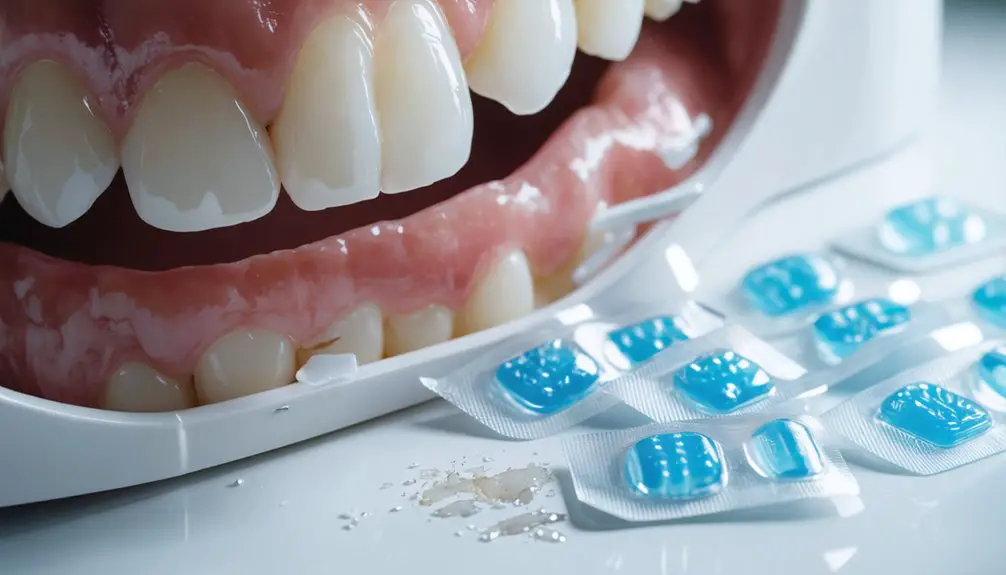
While both professional and at-home teeth whitening methods can effectively brighten your smile, they differ markedly in their approach, strength, and results.
Professional whitening utilizes higher peroxide concentrations (25-40%) under dental supervision, delivering dramatic results in a single session. At-home whitening uses milder solutions (3-10%) over extended periods.
- Professional treatments can lighten teeth up to 8 shades in 1-2 hours
- At-home kits typically achieve 3-6 shades improvement over weeks
- Professional whitening costs around $300+ but requires fewer treatments
- At-home options cost about $50, making them accessible for maintenance
- Professional supervision reduces risks and manages sensitivity immediately
For best results, consider professional whitening for initial treatment, followed by at-home methods for maintenance.
This combination maximizes effectiveness while managing costs and ensuring safety.
Essential Safety Guidelines for Best Results
Safe whitening strip usage demands careful attention to key guidelines that protect both your teeth and gums during treatment.
Using teeth whitening strips safely requires following essential rules that safeguard your dental health throughout the whitening process.
Despite common whitening myths, not all products are equally safe or effective. Always choose strips with the ADA Seal of Acceptance and carefully review product ingredients before use.
Follow application instructions precisely, limiting sessions to 20-30 minutes and maintaining proper breaks between treatments. Don’t exceed recommended frequency, as this can weaken enamel and increase sensitivity.
If you experience unusual pain or gum inflammation, stop treatment immediately and consult your dentist. Remember that strips won’t alter dental work like crowns or fillings, so adjust your expectations accordingly.
Monitor your oral health throughout the process and maintain good hygiene practices, including fluoride toothpaste use to protect enamel integrity.
Preventing Long-Term Enamel Damage
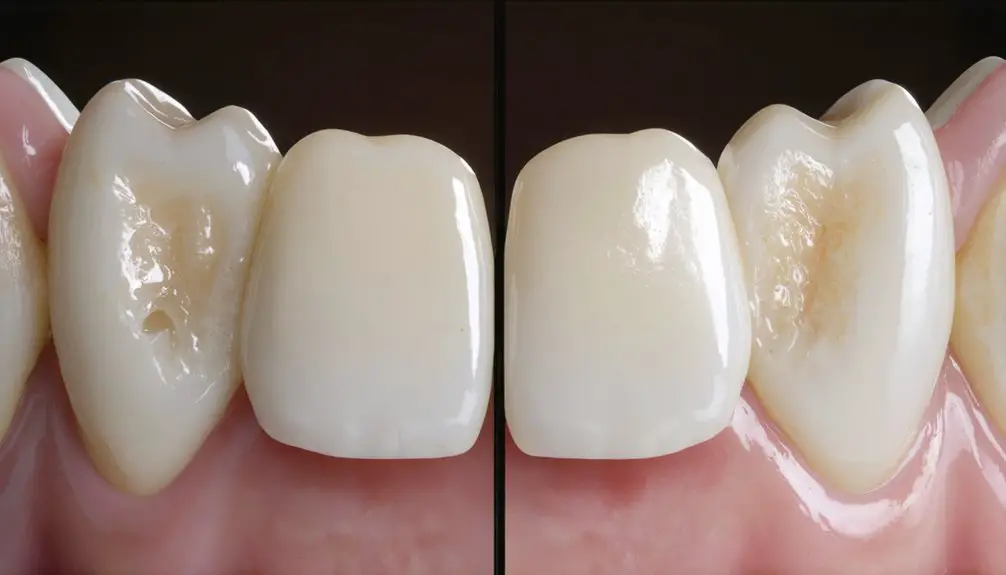
To safeguard your enamel during whitening treatments, you’ll need to understand how these products can potentially damage tooth structure over time.
Through safe whitening practices and proper enamel remineralization techniques, you can minimize risks while achieving desired results.
- Strictly follow manufacturer’s instructions for application duration and frequency to prevent overexposure
- Use fluoride-containing products between treatments to support enamel remineralization
- Schedule regular dental checkups to monitor your enamel’s condition
- Avoid acidic foods and drinks during whitening periods to prevent additional enamel softening
- Stop treatment immediately if you experience persistent sensitivity or notice white spots
Recovery Steps After Excessive Use
After excessive use of whitening strips, your teeth and gums need specific care to recover from potential damage and sensitivity.
Begin by rinsing your mouth thoroughly with lukewarm water to remove residual peroxide gel. Don’t brush, eat, or drink for at least 30 minutes to allow proper enamel remineralization.
Your recovery timeline should include using desensitizing toothpaste regularly and avoiding hot, cold, or acidic foods.
Apply soothing oils like vitamin E to irritated gums and stay hydrated. Prevent further staining by avoiding coffee, tea, and wine for 48 hours post-treatment.
Allow at least one week between treatments for complete healing. If you experience severe irritation or persistent discomfort, consult your dental professional immediately.
Resume gentle oral hygiene with non-abrasive toothpaste and a soft-bristle brush once your enamel has rehydrated.
Frequently Asked Questions
Can Whitening Strips Affect Existing Dental Work Like Crowns or Veneers?
You won’t whiten crowns or veneers with whitening strips since they’re non-porous, but you’ll risk sensitivity around restorations and potential discoloration that creates uneven coloring between natural teeth and dental work.
How Long Should I Wait Between Whitening Strip Treatments?
You’ll need to wait 3-6 months between whitening strip treatments. Follow the initial 7-14 day treatment duration, then maintain proper whitening frequency to protect your enamel and prevent sensitivity.
Is It Safe to Use Whitening Strips While Pregnant or Breastfeeding?
While pregnancy safety concerns warrant avoiding whitening strips until after delivery, breastfeeding precautions are less strict – you can safely use whitening strips while nursing if you follow product directions carefully.
Can Teenagers Safely Use Teeth Whitening Strips?
You shouldn’t use whitening strips until age 14-16, and only with your dentist’s approval. For safe teenage dental health, professional supervision guarantees proper whitening practices and protects developing teeth.
Do Whitening Strips Work on Teeth Stained by Medications or Antibiotics?
You’ll see limited results using whitening strips on medication impact or antibiotic effects since these cause deep intrinsic stains. Professional treatments like dental bleaching or veneers offer more effective solutions.
References
- https://www.drbobsdentalcare.com/are-whitening-strips-bad-for-your-teeth/
- https://ec.europa.eu/health/scientific_committees/opinions_layman/en/tooth-whiteners/l-3/5-tooth-whitening-products.htm
- https://www.webmd.com/oral-health/features/addictive-pursuit-of-pearly-whites
- https://vacadentistry.com/blog/4-dangers-of-over-the-counter-teeth-whitening/
- https://www.bu.edu/articles/2012/the-truth-about-teeth-whiteners/
- https://www.alpinedentalnj.com/blog/are-whitening-strips-safe
- https://olympicviewdental.com/are-teeth-whitening-strips-safe/
- https://www.healthline.com/health/do-whitening-strips-work
- https://crest.com/en-us/oral-care-tips/teeth-whitening/crest-whitestrips-instructions-safe-easy-teeth-whitening
- https://health.clevelandclinic.org/is-teeth-whitening-safe
